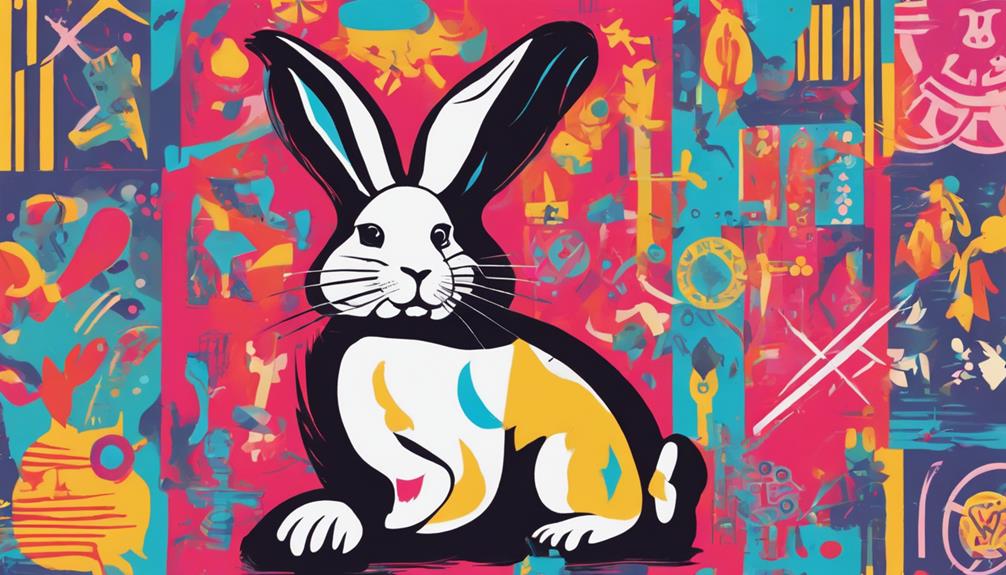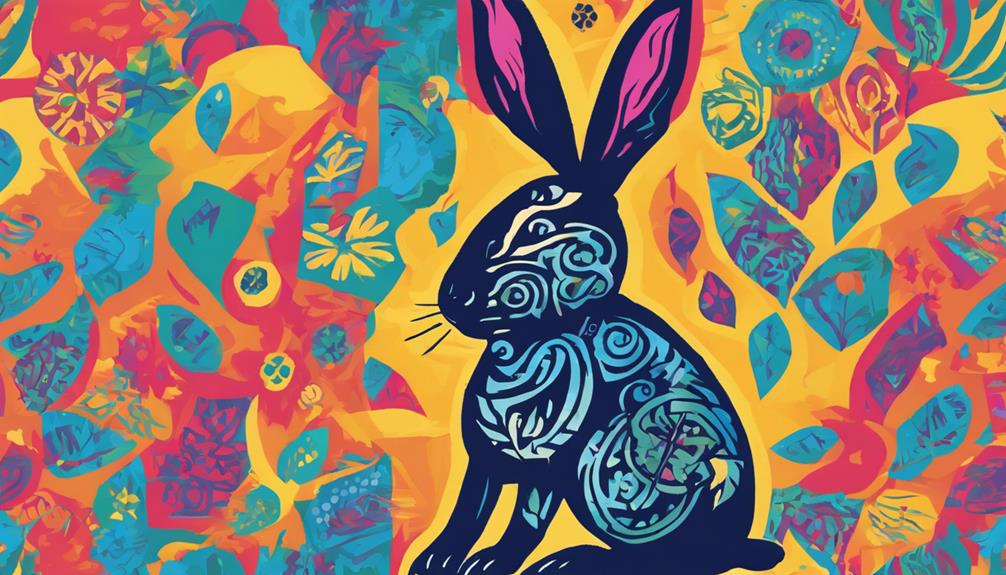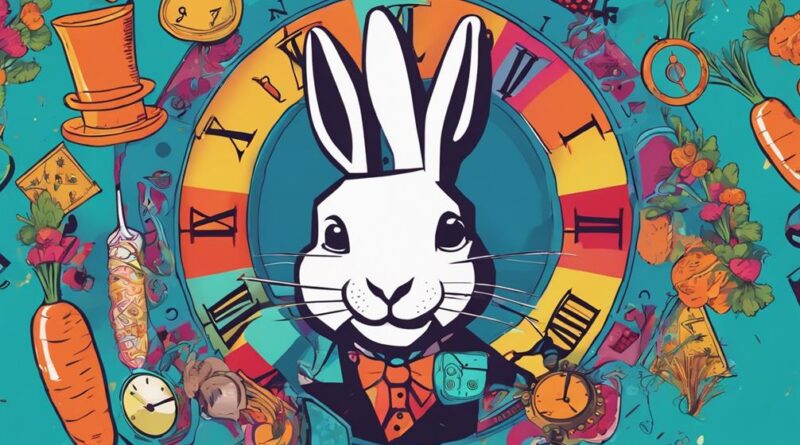Decoding Rabbit Symbolism in Pop Art
Delve into Pop Art's rabbit symbolism to uncover intriguing layers of meaning and social commentary. Artists in this genre skillfully utilize rabbits to convey deeper messages through their provocative works. From playful innocence to challenging power dynamics, rabbits in Pop Art offer a unique lens to analyze societal norms. The use of surrealist elements adds a dreamlike quality to the interpretations, inviting viewers to explore complex concepts and unconventional narratives. The evolving interpretations of rabbit symbolism in contemporary art continue to captivate audiences, pushing the boundaries of traditional views and offering fresh perspectives on vulnerability, transformation, and societal reflections.
Origins of Rabbit Symbolism
Delving into the historical roots of rabbit symbolism reveals a tapestry of cultural significance woven through centuries of art and storytelling. The rabbit has held various symbolic meanings across different cultures and time periods, each contributing to its rich historical significance.
In ancient Egyptian mythology, the rabbit was associated with the moon, fertility, and rebirth, symbolizing renewal and resurrection. This connection can be seen in artistic interpretations where rabbits are depicted alongside lunar motifs or as companions to lunar deities, highlighting their mystical and transformative qualities.
Moving forward in history, rabbits also played a prominent role in Chinese folklore, where they were revered for their cleverness and agility. This portrayal influenced artistic interpretations, showcasing rabbits as symbols of intelligence and resourcefulness. In European medieval art, the rabbit symbolized innocence and vulnerability, often depicted in religious manuscripts to represent purity and sacrifice.
The juxtaposition of these diverse cultural interpretations demonstrates the versatility of rabbit symbolism and its ability to adapt to different contexts.
As artistic styles evolved over time, the rabbit continued to be a popular motif in various forms of art, from paintings to literature. Its enduring presence in artistic expressions reflects the universal appeal and timeless charm of this symbol. By examining the historical significance and artistic interpretations of rabbit symbolism, we gain a deeper understanding of how this motif has transcended boundaries and resonated with audiences throughout history.
Evolution in Pop Art
The evolution of Pop Art showcases a dynamic shift in artistic expression, capturing the essence of contemporary culture through vibrant colors and bold imagery. This evolution can be seen in how artists have moved from traditional subjects to incorporating everyday objects and symbols into their works. Symbolism in Pop Art has played a crucial role in this evolution, as artists began using familiar images to convey deeper meanings and social commentary.
As Pop Art progressed, artists started to experiment with new techniques and materials, pushing the boundaries of traditional art forms. This evolution allowed for a more inclusive and diverse range of subjects to be explored, reflecting the changing cultural landscape of the time. Symbols such as rabbits began to appear in Pop Art during this period, representing themes of innocence, abundance, and fertility.
Moreover, the evolution of Pop Art also led to a fusion of different styles and influences, creating a unique visual language that resonated with a wider audience. Artists began to incorporate elements of popular culture, advertising, and mass media into their works, blurring the lines between high and low art. This shift in perspective challenged conventional notions of what art could be, opening up new possibilities for creative expression and interpretation.
Surrealistic Interpretations
Exploring the realm of Surrealistic interpretations in Pop Art unveils a mesmerizing journey into the subconscious mind of artists, where reality intertwines with the fantastical in a vivid display of creativity. Surrealism in Pop Art delves deep into dreamlike imagery and subconscious exploration, inviting you to ponder the intricate meanings behind the whimsical facades.
- Symbolic Surrealism: Artists often use surrealistic elements to symbolize deeper emotions and ideas that transcend traditional representations. Through dreamlike imagery, they convey complex concepts that challenge viewers to interpret beyond the surface.
- Psychological Depth: Surrealistic interpretations in Pop Art serve as a gateway to the artist's psyche, offering glimpses into their subconscious thoughts and feelings. The blend of reality and fantasy creates a rich tapestry of symbolism that reflects the complexities of human emotions.
- Unconventional Narratives: By incorporating surrealistic elements, artists can craft narratives that defy logic and linear storytelling. This unconventional approach allows for a more profound exploration of themes and concepts, encouraging viewers to engage with the artwork on a deeper, more introspective level.
In this realm of Surrealistic interpretations, artists use dreamlike imagery and subconscious exploration to challenge conventional artistic norms, inviting you to embark on a thought-provoking journey through the intricacies of the human mind.
Playfulness and Innocence
Within the realm of Pop Art, 'Playfulness and Innocence' emerge as captivating themes that infuse artworks with a sense of whimsy and purity. Artists often use these themes to evoke a childlike sense of wonder and joy in their audience. Innocence representation in Pop Art is frequently depicted through the use of bright colors, simplistic forms, and cheerful subjects like rabbits. These elements work together to create a visual language that speaks to the purity and simplicity of childhood.
Playful imagery is another key component of Pop Art that contributes to the overall theme of 'Playfulness and Innocence'. Artists often incorporate whimsical elements into their work, such as playful rabbits engaged in various activities like dancing, playing musical instruments, or wearing colorful costumes. These playful depictions serve to charm viewers and invite them into a world of imagination and delight.
The use of innocence representation and playful imagery in Pop Art not only adds a lighthearted touch to the artworks but also serves as a form of escapism for both the artist and the audience. By tapping into themes of innocence and playfulness, artists can transport viewers to a carefree and joyful place, allowing them to momentarily escape the complexities of the world around them.
Gender and Power Dynamics

Amidst the vibrant world of Pop Art, gender and power dynamics intertwine to shape narratives and challenge societal norms. In this artistic realm, artists often use rabbit symbolism to delve into the complexities of gender dynamics and power struggles. Here's a closer look at how these themes play out in Pop Art:
- Subversion of Traditional Gender Roles: Pop Art frequently challenges traditional gender roles by depicting rabbits in unconventional ways. These artworks may showcase female rabbits in positions of power and authority, breaking away from stereotypical gender norms.
- Symbolism of Strength and Resilience: Rabbits are often associated with traits like agility and quickness. In the context of gender dynamics, these qualities can symbolize the strength and resilience of individuals overcoming power struggles and societal expectations.
- Exploration of Power Imbalances: Through rabbit symbolism, artists in Pop Art explore the nuances of power imbalances in society. By portraying rabbits in scenarios where power dynamics are at play, these artworks shed light on the complexities of navigating and challenging established power structures.
Within the realm of Pop Art, the representation of rabbits offers a unique lens through which to examine gender dynamics and power struggles, inviting viewers to contemplate and reflect on the intricacies of these themes in contemporary society.
Political and Social Commentary
Rabbit symbolism in Pop Art serves as a poignant vehicle for conveying political and social commentary, shedding light on contemporary issues through artistic expression. In the realm of feminist critique, rabbits have been utilized to challenge traditional gender roles and power dynamics. Artists often depict rabbits in roles that defy societal norms, showcasing the strength and resilience of femininity. This subversion of expectations serves as a powerful commentary on the need for gender equality and the dismantling of oppressive structures.
Moreover, rabbits are frequently employed in Pop Art as a tool for satire and humor when addressing political matters. Through playful and whimsical depictions, artists can tackle serious subjects in a more approachable manner. By using rabbits as avatars for political figures or symbols of societal issues, artists can inject levity into their critiques, making them more engaging and thought-provoking for viewers. This blending of satire and symbolism allows for complex ideas to be conveyed in a digestible and entertaining way.
In essence, the use of rabbits in Pop Art for political and social commentary is a nuanced and impactful practice. By combining elements of feminist critique, satire, and humor, artists can address pressing issues while inviting audiences to reflect on the world around them in a creative and engaging manner.
Cultural Influences and Adaptations

Cultural influences and adaptations play a significant role in shaping the portrayal and interpretation of rabbit symbolism within the realm of Pop Art. When exploring rabbit symbolism in this context, cross-cultural interpretations and artistic adaptations offer a multifaceted lens through which to view this intriguing motif.
- Cross-Cultural Interpretations: Pop artists often draw inspiration from diverse cultural backgrounds, infusing rabbit symbolism with meanings that transcend geographical boundaries. This fusion of cultural perspectives adds layers of complexity to the interpretation of rabbits in art, inviting viewers to consider the universal themes woven into these representations.
- Artistic Interpretations: Artists leverage rabbit symbolism to convey a range of emotions and concepts, from innocence and playfulness to fertility and abundance. Through artistic interpretations, rabbits in Pop Art serve as versatile symbols that can be imbued with personal or societal significance, reflecting the artist's unique vision and message.
- Symbolic Adaptations: As rabbit symbolism migrates across different artistic movements and styles, it undergoes symbolic adaptations that reflect evolving societal norms and artistic trends. These adaptations breathe new life into the age-old symbol of the rabbit, illustrating its enduring relevance in the ever-changing landscape of Pop Art.
Contemporary Rabbit Symbolism
In the realm of contemporary art, the symbolism associated with rabbits continues to evolve and captivate audiences with its dynamic interpretations. Modern artists have taken the traditional symbolism of rabbits representing fertility, abundance, and agility to new heights through their innovative and thought-provoking creations.
One of the modern interpretations of rabbit symbolism in art is its portrayal as a symbol of vulnerability and innocence. Artists often depict rabbits in fragile or delicate situations to evoke emotions of tenderness and empathy from viewers. This representation challenges the conventional view of rabbits as merely cute or whimsical creatures, adding layers of complexity to their symbolic meaning.
Moreover, rabbits in contemporary art are frequently used to symbolize the concept of rebirth and transformation. Through various artistic expressions, rabbits are depicted undergoing metamorphosis or emerging from unconventional settings, symbolizing the idea of new beginnings and growth. This interpretation resonates with audiences seeking hope and renewal in the face of challenges.
Frequently Asked Questions
Can Rabbits Symbolize Luck or Fertility in Pop Art?
In pop art, rabbits can definitely symbolize luck and fertility. These fluffy creatures often represent prosperity and abundance in artistic expressions. Their symbolism goes beyond just gender norms, tapping into universal themes of growth and abundance.
Artists use rabbits to infuse their work with a sense of positivity and good fortune. Through their whimsical charm, rabbits add a touch of magic and hope to pop art creations.
How Do Artists Use Rabbits to Challenge Traditional Gender Roles?
In pop art, artists use rabbits to challenge traditional gender roles by exploring gender fluidity and subverting societal norms. Through their artwork, they challenge stereotypes and aim to disrupt expectations of what's considered masculine or feminine.
Are There Any Hidden Meanings Behind the Size of Rabbits in Artworks?
When exploring symbolism in artworks, consider the significance of the size of rabbits.
Artists often use the scale of rabbits to convey deeper meanings and provoke artistic interpretations.
The choice to depict rabbits in various sizes can symbolize concepts like power dynamics, vulnerability, or even societal hierarchies.
Do Rabbits in Pop Art Always Represent Innocence and Playfulness?
In pop art, rabbits often symbolize innocence and playfulness, but their meanings can vary based on artistic and cultural interpretations. These fluffy creatures may represent more than just cuteness; they can also carry symbolic interpretations related to fertility, rebirth, or even trickery.
While traditionally associated with notions of purity, rabbits in pop art can challenge gender dynamics and offer deeper insights into societal norms and values. Their presence adds layers of complexity to the artistic narrative.
Are There Cultural Taboos Associated With Rabbits in Certain Artworks?
In certain artworks, cultural taboos are intertwined with rabbit symbolism due to practices like rabbit sacrifices in some cultures. Artists may depict taboo themes through rabbit anatomy to challenge societal norms or provoke thought.
The juxtaposition of innocence and darker themes can create a complex narrative within artworks, inviting viewers to contemplate the deeper meanings behind the representation of rabbits.
Conclusion
In conclusion, rabbit symbolism in pop art has evolved from its origins to encompass a wide range of interpretations. From playful and innocent portrayals to deeper political and social commentaries, the rabbit has become a versatile symbol in the art world.
Its adaptability and cultural influences continue to inspire artists to explore new meanings and representations in contemporary works. The rabbit remains a powerful and intriguing symbol that captures the imagination of both artists and viewers alike.
